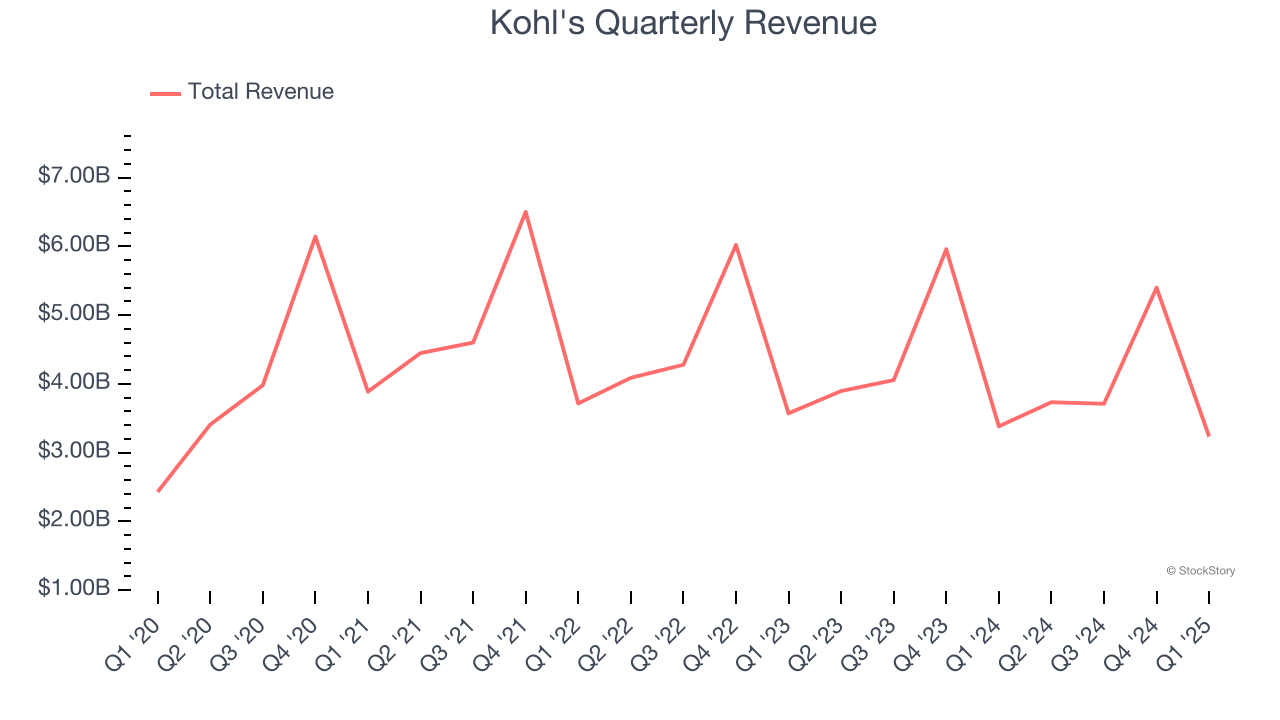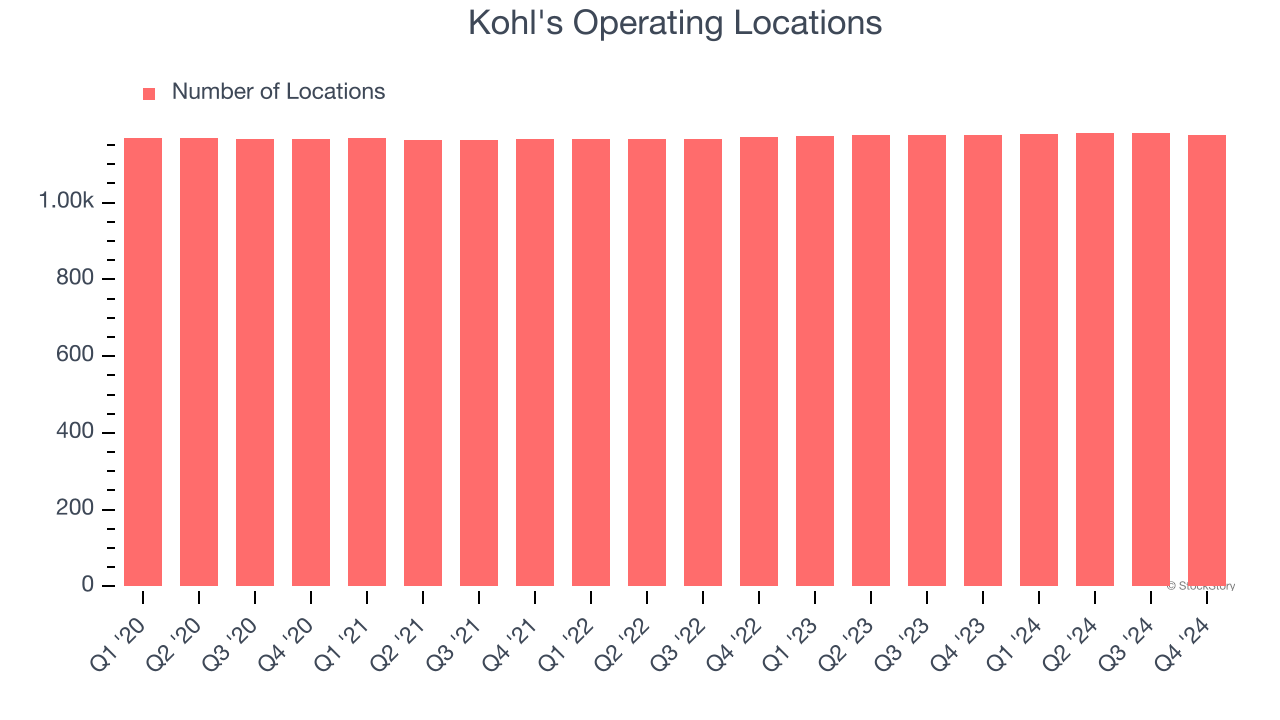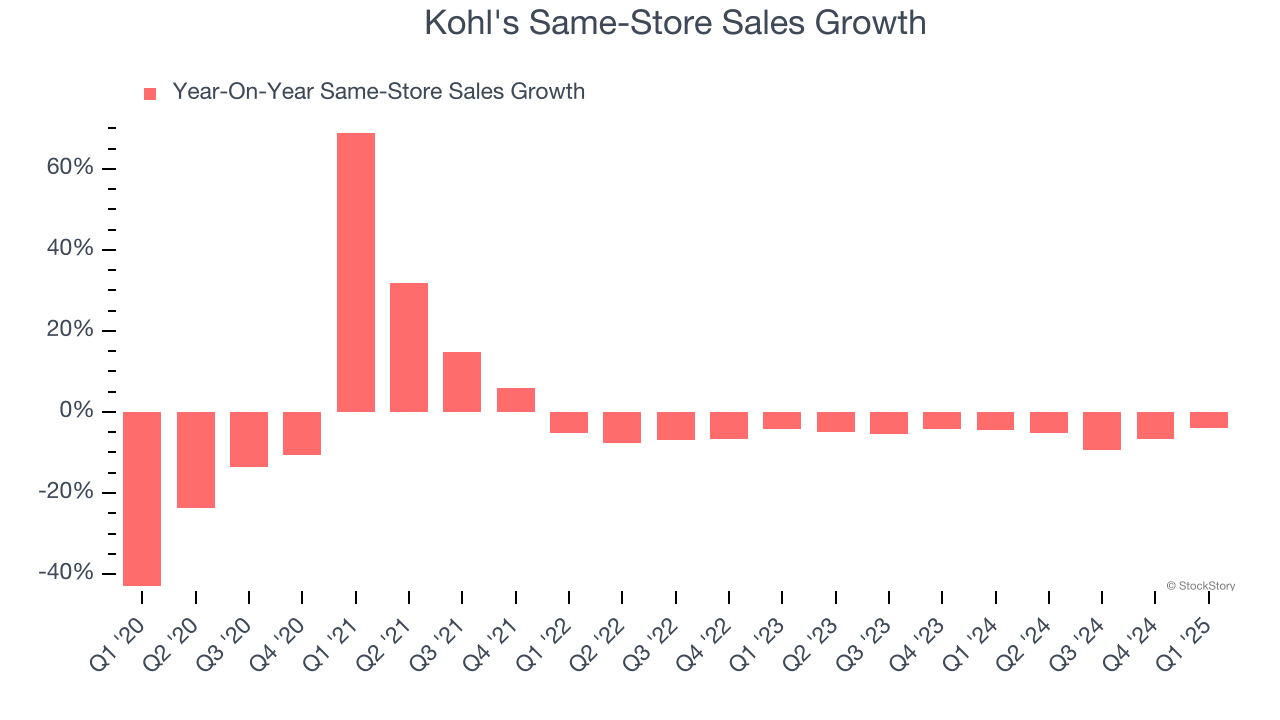
Department store chain Kohl’s (NYSE: KSS) reported Q1 CY2025 results exceeding the market’s revenue expectations, but sales fell by 4.4% year on year to $3.23 billion. Its GAAP loss of $0.13 per share was 41.1% above analysts’ consensus estimates.
Is now the time to buy Kohl's? Find out by accessing our full research report, it’s free.
Kohl's (KSS) Q1 CY2025 Highlights:
- Revenue: $3.23 billion vs analyst estimates of $3.2 billion (4.4% year-on-year decline, 1% beat)
- EPS (GAAP): -$0.13 vs analyst estimates of -$0.22 (41.1% beat)
- Adjusted EBITDA: $235 million vs analyst estimates of $221.6 million (7.3% margin, 6.1% beat)
- EPS (GAAP) guidance for the full year is $0.35 at the midpoint, missing analyst estimates by 47.4%
- Operating Margin: 1.9%, in line with the same quarter last year
- Free Cash Flow was -$202 million compared to -$133 million in the same quarter last year
- Same-Store Sales fell 3.9% year on year, in line with the same quarter last year
- Market Capitalization: $901.7 million
Michael Bender, Kohl’s Interim Chief Executive Officer, said, “I am honored to assume the role of Interim CEO at such an important time for our company. Kohl’s has a tremendous opportunity to build on our strong foundation of over 1,100 conveniently located stores and a large and loyal customer base.”
Company Overview
Founded as a corner grocery store in Milwaukee, Wisconsin, Kohl’s (NYSE: KSS) is a department store chain that sells clothing, cosmetics, electronics, and home goods.
Sales Growth
A company’s long-term sales performance is one signal of its overall quality. Any business can put up a good quarter or two, but the best consistently grow over the long haul.
With $16.07 billion in revenue over the past 12 months, Kohl's is one of the larger companies in the consumer retail industry and benefits from a well-known brand that influences purchasing decisions. However, its scale is a double-edged sword because there is only so much real estate to build new stores, placing a ceiling on its growth. For Kohl's to boost its sales, it likely needs to adjust its prices or lean into foreign markets.
As you can see below, Kohl’s demand was weak over the last six years (we compare to 2019 to normalize for COVID-19 impacts). Its sales fell by 3.7% annually as it didn’t open many new stores and observed lower sales at existing, established locations.

This quarter, Kohl’s revenue fell by 4.4% year on year to $3.23 billion but beat Wall Street’s estimates by 1%.
Looking ahead, sell-side analysts expect revenue to decline by 5.6% over the next 12 months, a slight deceleration versus the last six years. This projection is underwhelming and implies its products will face some demand challenges.
Software is eating the world and there is virtually no industry left that has been untouched by it. That drives increasing demand for tools helping software developers do their jobs, whether it be monitoring critical cloud infrastructure, integrating audio and video functionality, or ensuring smooth content streaming. Click here to access a free report on our 3 favorite stocks to play this generational megatrend.
Store Performance
Number of Stores
A retailer’s store count often determines how much revenue it can generate.
Over the last two years, Kohl's has kept its store count flat while other consumer retail businesses have opted for growth.
When a retailer keeps its store footprint steady, it usually means demand is stable and it’s focusing on operational efficiency to increase profitability.
Note that Kohl's reports its store count intermittently, so some data points are missing in the chart below.

Same-Store Sales
The change in a company's store base only tells one side of the story. The other is the performance of its existing locations and e-commerce sales, which informs management teams whether they should expand or downsize their physical footprints. Same-store sales is an industry measure of whether revenue is growing at those existing stores and is driven by customer visits (often called traffic) and the average spending per customer (ticket).
Kohl’s demand has been shrinking over the last two years as its same-store sales have averaged 5.5% annual declines. This performance isn’t ideal, and we’d be concerned if Kohl's starts opening new stores to artificially boost revenue growth.

In the latest quarter, Kohl’s same-store sales fell by 3.9% year on year. This decrease represents a further deceleration from its historical levels. We hope the business can get back on track.
Key Takeaways from Kohl’s Q1 Results
We were impressed by how significantly Kohl's blew past analysts’ gross margin, EPS, and EBITDA expectations this quarter. We were also excited its revenue outperformed Wall Street’s estimates. On the other hand, its full-year EPS guidance missed. Overall, we think this was a decent quarter with some key metrics above expectations. The stock traded up 3.4% to $8.40 immediately after reporting.
Kohl's had an encouraging quarter, but one earnings result doesn’t necessarily make the stock a buy. Let’s see if this is a good investment. If you’re making that decision, you should consider the bigger picture of valuation, business qualities, as well as the latest earnings. We cover that in our actionable full research report which you can read here, it’s free.





